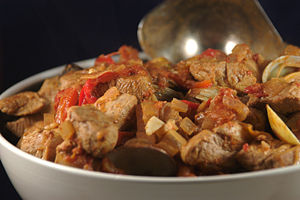Portuguese pork stew with clams (amêijoas com carne de porco à alentejana): Difference between revisions
Jump to navigation
Jump to search

imported>Ro Thorpe m (normal usage) |
imported>Caesar Schinas m (Bot: Update image code) |
||
| Line 1: | Line 1: | ||
{{subpages}} | {{subpages}} | ||
{{Image|Puerco Alentejana.jpg|right|300px|'''Portuguese pork stew with clams'''. Click the photo for the exact recipe of this version of the dish.}} | |||
'''Portuguese pork stew with clams (''amêijoas com carne de porco à alentejana'')''' is a traditional Portuguese dish, particularly near the Atlantic coast, where clams are easily found. It is called ''alentejana'' as being in the manner of the Alentejo, a farming province where the highest quality young pigs are traditionally raised on a diet of acorns. It is basically a braised dish in the rustic manner of innumerable stews such as [[beef bouguignon]] or [[sauerbraten]]. In this case, chunks of pork are marinated, browned, then stewed in wine with tomatoes, pimientos, and various seasonings. The clams are added for a few minutes at the end of the cooking and the finished mixture is served over slices of fried bread with wedges of lemon. <ref>''In Search of the Perfect Meal'', by Roy Andries de Groot, St. Martin's Press, New York, 1986, "A Formative Dish: Portuguese-Style Pork with Fresh Clams," pages 49-52.</ref> | '''Portuguese pork stew with clams (''amêijoas com carne de porco à alentejana'')''' is a traditional Portuguese dish, particularly near the Atlantic coast, where clams are easily found. It is called ''alentejana'' as being in the manner of the Alentejo, a farming province where the highest quality young pigs are traditionally raised on a diet of acorns. It is basically a braised dish in the rustic manner of innumerable stews such as [[beef bouguignon]] or [[sauerbraten]]. In this case, chunks of pork are marinated, browned, then stewed in wine with tomatoes, pimientos, and various seasonings. The clams are added for a few minutes at the end of the cooking and the finished mixture is served over slices of fried bread with wedges of lemon. <ref>''In Search of the Perfect Meal'', by Roy Andries de Groot, St. Martin's Press, New York, 1986, "A Formative Dish: Portuguese-Style Pork with Fresh Clams," pages 49-52.</ref> | ||
== References == | == References == | ||
<references/> | <references/> | ||
Latest revision as of 08:45, 8 June 2009
Portuguese pork stew with clams (amêijoas com carne de porco à alentejana) is a traditional Portuguese dish, particularly near the Atlantic coast, where clams are easily found. It is called alentejana as being in the manner of the Alentejo, a farming province where the highest quality young pigs are traditionally raised on a diet of acorns. It is basically a braised dish in the rustic manner of innumerable stews such as beef bouguignon or sauerbraten. In this case, chunks of pork are marinated, browned, then stewed in wine with tomatoes, pimientos, and various seasonings. The clams are added for a few minutes at the end of the cooking and the finished mixture is served over slices of fried bread with wedges of lemon. [1]
References
- ↑ In Search of the Perfect Meal, by Roy Andries de Groot, St. Martin's Press, New York, 1986, "A Formative Dish: Portuguese-Style Pork with Fresh Clams," pages 49-52.
